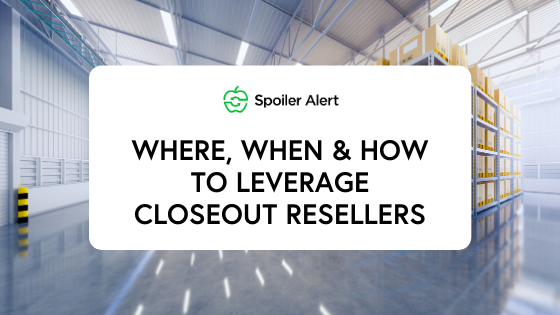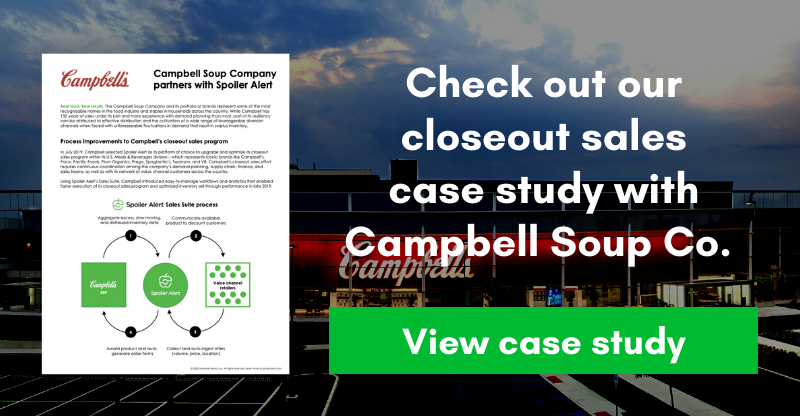
The spectrum of outlets that purchase surplus food inventory on the secondary market is vast and fragmented. As a result, it can be overwhelming for food brands to figure out who are the “right” customers to work with in this channel. One question we get frequently is how food brands can best leverage closeout brokers and wholesalers (which we’ll collectively refer to as “resellers” in this post) alongside their discount retailer customers as part of their closeout customer portfolio.
Because resellers act as intermediaries and need to make a margin on what they turn around and re-sell to their own customers, they typically won’t offer to pay as high a price as direct sales to discount retailer customers would. In spite of this drawback, resellers remain an important component of an effective (and diversified) customer portfolio strategy for food brands. It does, however, take knowledge and effort to leverage them correctly for the best results.
Closeout resellers & access to the long tail
There are a handful of large discount retailers who source opportunistically that food brands should include in their liquidation customer portfolios as a best practice when possible. Organizations like Grocery Outlet, Big Lots, and 99 Cents Only (to name a few) are critical partners and often account for the majority of liquidated volume for large food manufacturers. With upwards of hundreds (or even thousands) of stores, large discount retailers tend to purchase truckload quantities of similar inventory on a regular cadence due to their sophisticated supply chain operations, dedicated food buyers, and regional distribution centers. As a result, it makes sense for large food brands to work with them directly (and not through a reseller) as part of a successful liquidation sales program.
However, market research shows that the majority of demand for opportunistically purchased inventory is highly fragmented, made up of thousands of independently-owned discount retail stores purchasing primarily through resellers. Our experience is that the majority of these small discount grocery stores are located in remote or rural areas, where they often serve a very important role in their communities, many of which are home to high proportions of low income residents and not well served by conventional grocery stores (measured either by proximity or product availability).
Considerations for selling directly to retailers
Accessing the fragmented long tail of the liquidation market can be a lot of work for food brands to do themselves, though such efforts may result in higher recovery rates. Here we outline some considerations of whether smaller discount stores or chains are worth the effort:
- Volume & Logistics: Unlike large discount retailers, small independent outlets usually can’t take full truckload quantities of inventory at once, and the costs and coordination efforts required for less than truckload volumes can be prohibitive for them (especially if inventory is located hundreds or thousands of miles away). If truckload quantities are the goal (or customer pickups aren’t allowed), oftentimes resellers can consolidate orders across a portfolio of small customers into one large order and handle marketing and distribution to these smaller outlets. In these instances, resellers are providing a valuable service that is well worth the lower margin they are offering.
- Variety: Retailers are - by their nature - looking for a diversity of SKUs across many different brands and product categories. Whereas large discount retailers have the capacity to source directly from hundreds of suppliers, smaller outlets (who also need variety) will need to take lower quantities of a given item. As a result, small retailers may prefer inventory consisting of mixed pallets or even mixed cases (as is common with the smallest stores), which are sometimes referred to as “banana boxes”. With few exceptions, food manufacturers are usually not able to offer smaller retailers this kind of product mix through their liquidation programs. Because resellers are pulling inventory from a number of suppliers, they can mix and match SKUs from a variety of sources and provide smaller outlets with the mixed pallets and banana boxes for which they are in the market.
There are, of course, exceptions to the rules. For one, there are a few small discount retail chains and stores sourcing opportunistically that (though not always easy to find) have the logistical capacity to pick up inventory directly at suppliers’ facilities (if and when customer pickups are allowed). This is particularly relevant when distribution centers are within close proximity to the outlets.
Another exception to this is when the source of supply is coming from wholesale grocery distributors. These businesses carry thousands of SKUs and tend to end up with lower quantities of high-quality inventory, co-located at distribution centers across the country.
Considerations for selling through resellers
Just as benefits exist in working directly with small retailers, so too are there compelling reasons to partnering with resellers. Such relationships require work and expectations management. Below are a few rules of thumb that we recommend to food brands:
- Make sure that resellers aren’t selling direct to your current customers: Just like food suppliers have a portfolio of liquidation customers, so too do resellers, and these two pools of outlets shouldn’t overlap. This concept applies to suppliers’ existing closeout network and primary retail customer network, including direct-to-consumer ecommerce marketplaces like Amazon. Suppliers should be explicit with resellers about which outlets are off limits. High quality closeout resellers will respect this request and appreciate this level of transparency.
- Set clear turnaround time expectations: It is not uncommon for resellers to “pre-sell” inventory prior to placing an order. This means that they will market inventory to their network of small customers, process orders from these customers, and then finally aggregate these orders and submit an offer. While this added exposure and reach can be valuable, this process can take time, which may not work for every liquidation program’s timeline or perishability constraints. Food brands should clearly communicate offer deadlines and ensure that their resellers adhere to these deadlines.
- Part ways with resellers that aren’t actively placing orders: We always advocate quality over quantity, and if certain resellers are not actively making purchases, it is best to remove them from a customer portfolio. Restricting resellers in one’s portfolio to only those that are successful in reselling inventory serves to limit the market exposure of a food brand’s products in the secondary market, which can create a sense of scarcity and increase demand.
There is a huge range of resellers out there, many of which are terrific partners. However, those that advertise themselves as a magical one stop shop capable of solving all of a food brand’s excess inventory problems should be viewed with a healthy amount of skepticism. While the approach of partnering with a single reseller can work for some food brands (especially smaller ones without the resources to manage a robust liquidation program), we find that the reality of working with such “take all” resellers does not match the promises that they make in their marketing materials.
Ultimately, the most successful closeout programs leverage resellers as part of a larger portfolio of diverse customers, founded on setting and communicating clear and specific expectations.
.png?width=250&name=SpoilerAlert_WhiteLogo_LeftStacked%20(7).png)
